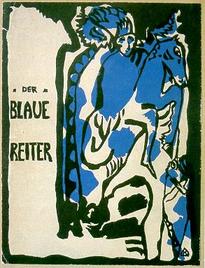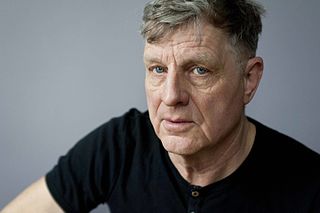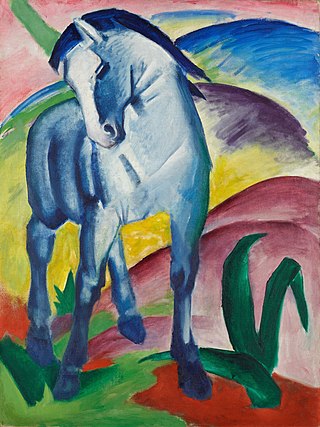
Bildnis Bernhard Koehler, 1910

Bernhard Koehler (born 7 November 1849 in Berlin; died 30 March 1927 in Berlin) was a German industrialist and art collector.


Bernhard Koehler (born 7 November 1849 in Berlin; died 30 March 1927 in Berlin) was a German industrialist and art collector.
Koehler, who came from a family of merchants, grew up in Berlin. In 1876, Koehler founded the Mechanische Werkstätten (lit. 'Mechanical Workshops'). [1] The company, located in Berlin-Kreuzberg, was internationally successful and allowed Koehler to amass a substantial fortune.
Beside his businesswork Koehler became an art collector. In the 1900s, Koehler came into contact with German painters in Munich such as August Macke or Franz Marc via his niece Elisabeth Gerhardt, who in 1909 eventually married Macke. He became a patron of Macke and gave him 300 Franc for a journey to Paris. Since 1910, Koehler also gave 200 Mark each month to Franz Marc, who was rather poor. In return for his financial aid he received several paintings from both Macke and Marc. [2]
In 1911, Koehler came into contact with artists of Neue Künstlervereinigung München. He was a financier of the almanach by Der Blaue Reiter in Munich and in 1913 of the Erster Deutscher Herbstsalon in Berlin, which was organized by Herwarth Walden, August Macke and Franz Marc. [3] In 1914, he gave financial help to Franz Marc for his journey to Tunis.
During his lifetime, Koehler's art collection was located in his family home in Berlin. In 1927, Koehler died and was buried in Berlin-Neukölln. His son Bernhard Koehler (1882–1964) became owner of the art collection. He sold some paintings at the end of the 1920s and some paintings got lost during World War II, as the factory and the family home got destroyed. Some of the more important paintings, however, were given to the Nationalgalerie during the war and came to Russia at the end of the War due to art theft. [4] Some other paintings of Koehlers art collections are located in the Städtischen Galerie im Lenbachhaus in Munich today.

Franz Moritz Wilhelm Marc was a German painter and printmaker, one of the key figures of German Expressionism. He was a founding member of Der Blaue Reiter, a journal whose name later became synonymous with the circle of artists collaborating in it.

Der Blaue Reiter is a designation by Wassily Kandinsky and Franz Marc for their exhibition and publication activities, in which both artists acted as sole editors in the almanac of the same name, first published in mid-May 1912. The editorial team organized two exhibitions in Munich in 1911 and 1912 to demonstrate their art-theoretical ideas based on the works of art exhibited. Traveling exhibitions in German and other European cities followed. The Blue Rider disbanded at the start of World War I in 1914.

August Robert Ludwig Macke was a German Expressionist painter. He was one of the leading members of the German Expressionist group Der Blaue Reiter. He lived during a particularly active time for German art: he saw the development of the main German Expressionist movements as well as the arrival of the successive avant-garde movements which were forming in the rest of Europe. As an artist of his time, Macke knew how to integrate into his painting the elements of the avant-garde which most interested him. Like his friend Franz Marc and Otto Soltau, he was one of the young German artists who died in the First World War.

Ivan Albertovich Puni was a Russian avant-garde artist.

The Lenbachhaus is a building housing an art museum in Munich's Kunstareal.
Klaus Peter Brehmer, was a German painter, graphic artist and filmmaker. From 1971 to 1997 he was professor at the Hochschule für bildende Künste Hamburg.
Bo Christian Larsson is a Swedish artist who works mostly with large-sized drawings, installations, performances and objects.

Rainer Fetting is a German painter and sculptor.

Nanne Meyer, is a German artist. She is one of the first women artists of the postwar generation who works primarily in drawing. Meyer lives and works in Berlin.

Robert Genin was a Russian artist, painter, draftsman, and illustrator of Jewish origin, who lived in the Russian Empire, Germany, France, Switzerland and the USSR.

Haralampi G. Oroschakoff is an Austrian painter, writer and publisher. He is considered a pioneer of the East-West dialogue in art and a reviver of the reception of Eastern iconography in Western painting. Oroschakoff participated in TEDxLambeth 2019 as a speaker regarding the subject matter of conceptualism.
Rudi Tröger is a German painter and university professor. From 1967 to 1992 he was a professor for painting art at the Academy of Fine Arts, Munich.
Günther Franke was a German gallery owner, art dealer and collector.

Blue Horse I is an oil painting by Franz Marc completed in 1911. It is one of the painter's most famous works and is part of the collection of the Städtische Galerie im Lenbachhaus in Munich. The painting was part of several exhibitions that Franz Marc and fellow Russian painter Wassily Kandinsky presented to the public under the name Der Blaue Reiter from late 1911 until 1914.

Portrait with Apples, also known as Elisabeth with Apples, is an oil-on-canvas painting executed in 1909 by the German Expressionist painter August Macke. It shows his wife Elisabeth Gerhardt and was created shortly after their wedding. Macke had studied the work of the Fauve artists during his honeymoon in Paris, and the painting shows their influence. It marks the beginning of his public artistic appreciation. The work belongs to the collection of the Städtische Galerie im Lenbachhaus, in Munich.

Indians on Horseback is an oil-on-canvas painting executed in 1911 by the German Expressionist painter August Macke. It was created when the artist was under the influence of Cubism and had joined Der Blaue Reiter group through his friend Franz Marc. The painting belongs to the collection of the Städtische Galerie im Lenbachhaus, in Munich. It was donated by the Bernhard and Elly Koehler Foundation in 1965.

Margarete Oppenheim was a German art collector and patron. She was among the first personalities to collect works of modern art in Germany and owned one of the largest collection in Germany.
Julius Bernhard Stern was a German Jewish banker, art collector and philanthropist. (Not to be confused with the art dealer Julius Stern.